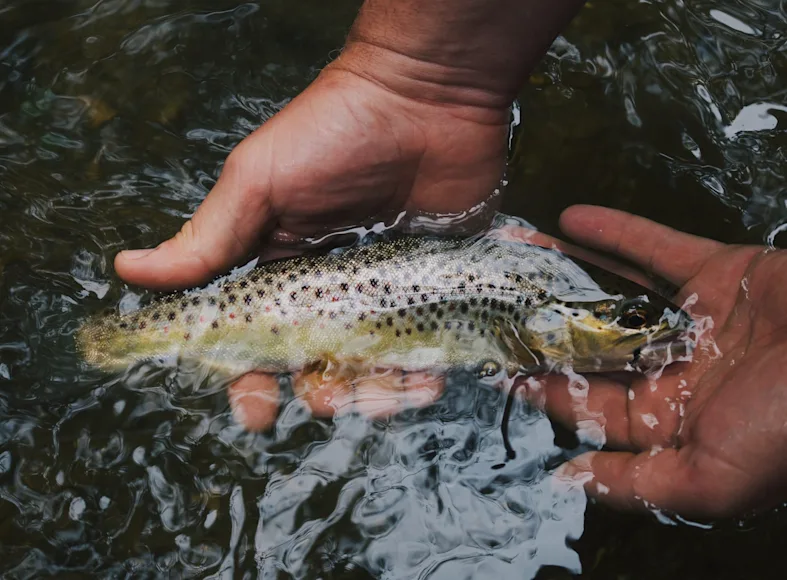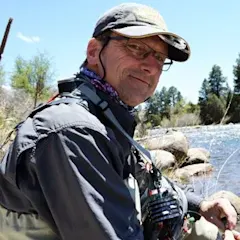Should you get into Euro nymphing? Well, consider this: If you’re interested in fast cars, your experts are NASCAR and Formula 1. If you’re into basketball, perhaps your role models are the NBA. And if you want to catch more trout, you will want to try Euro nymphing, the way the “pros” fish do on the competition fly-fishing circuit.
Competition fly-fishers spend a lot of time, money, and effort to win their medals. They need to catch trout, and they mostly do it by fishing nymphs on a tight line. The style has become known as Euro nymphing—after the Czech, Polish, French, and Spanish competitors who perfected it—and in recent years, this style of fly fishing has really caught on among regular fly anglers too. In this guide, we’ll cover everything you need to know—the gear, the rigs, the flies, and the skills—to get started in Euro nymphing.
What Is Euro Nymphing?
In a nutshell, Euro nymphing is a type of tight-light nymphing. What is tight-light nymphing? Well, in short, it’s fly fishing with nymphs without a strike indicator. We all enjoy casting to trout feeding on the surface. But the competition angler has three hours to catch as many trout as possible; he or she can’t wait around for the fish to rise. Trout spend most of their time near the stream bed, so the goal of Euro nymphing is to get your fly down where the fish are, as quickly as possible.
Table of Contents
Euro Nymphing Fly Rods
Euro Fly Reels
Euro Lines
Can You Euro Nymph with a Regular Fly Rod?
5 of the Best Euro Nymphs for Beginners
How to Set Up a Fly Rod for Euro Nymphing
5 Fishing Tips for European Nymphing
Know When and When Not to Try Euro Nymphing
The European Approach to Nymphing

Here’s a simple—but effective—assortment of slim, heavy flies for Euro nymphing. (Photo / Morgan Lyle)
Euro Nymphing Gear
Euro Nymphing Fly Rods
Tackle companies offer a good selection of fly rods for Euro nymphing. They’re long and light—the better to hold your fly line off the water. Sage, Orvis, and G. Loomis all offer top-model rods designed for this kind of fishing, in 10- or 10.5-foot lengths and line weights from 2 to 4. Euro rods usually have soft tip sections, to make it easier to lob a leader and flies and to protect fine tippets by flexing with every surge and struggle of a hooked trout. It’s also common for Euro nymphing rods to have non-glossy “stealth” finishes; because you’re often close to your fish, it’s a good idea to prevent sudden flashes of sun glare.
Euro Fly Reels
The best fly fishing reels for trout that are designed for Euro nymphing feature extra-tight tolerances in hopes of keeping very thin lines from getting trapped between spool and cage. That’s helpful. Still, a standard fly reel will get the job done. There’s not a ton of stripping and reeling in Euro nymphing. You will, however, want to keep any eye on that running line when pulling from the reel for a longer cast.
Euro Fly Lines
Some Euro nymphers don’t bother with fly line at all; they just spool up their reels with sturdy monofilament. A full-mono rig is certainly capable of playing and landing trout, and it does offer great sensitivity for detecting strikes. But it’s also prone to coiling, and less comfortable to handle than a fly line. Fortunately, there are lots of purpose-built Euro nymphing lines available, such as Rio’s Euro Nymph line, sold in sizes 2 through 5. Euro lines thin, low-stretch, taper-free, and easier to cast than all-mono rigs. You will, however, be frustrated if you try to use one to cast a dry fly 40 feet.
Can You Euro Nymph with a Regular Fly Rod?
You can absolutely nymph the Euro way with your standard 9-foot 5-weight setup—but your fishing will look and feel different. You won’t be false-casting and unrolling tight loops of line. Instead, you’ll flick your nymph upstream of likely trout lies with as little line beyond the rod tip as possible. Follow the fly as it drifts downstream, and when it starts to swing from the line coming tight, then lift, lob, and drift again. Strive to have your leader angle sharply down into the water. Watch and feel for any pause in the drift, and set the hook whenever it happens.
The best way to adapt your all-purpose fly rig for Euro nymphing is by adding a long, specialized leader to your fly line.
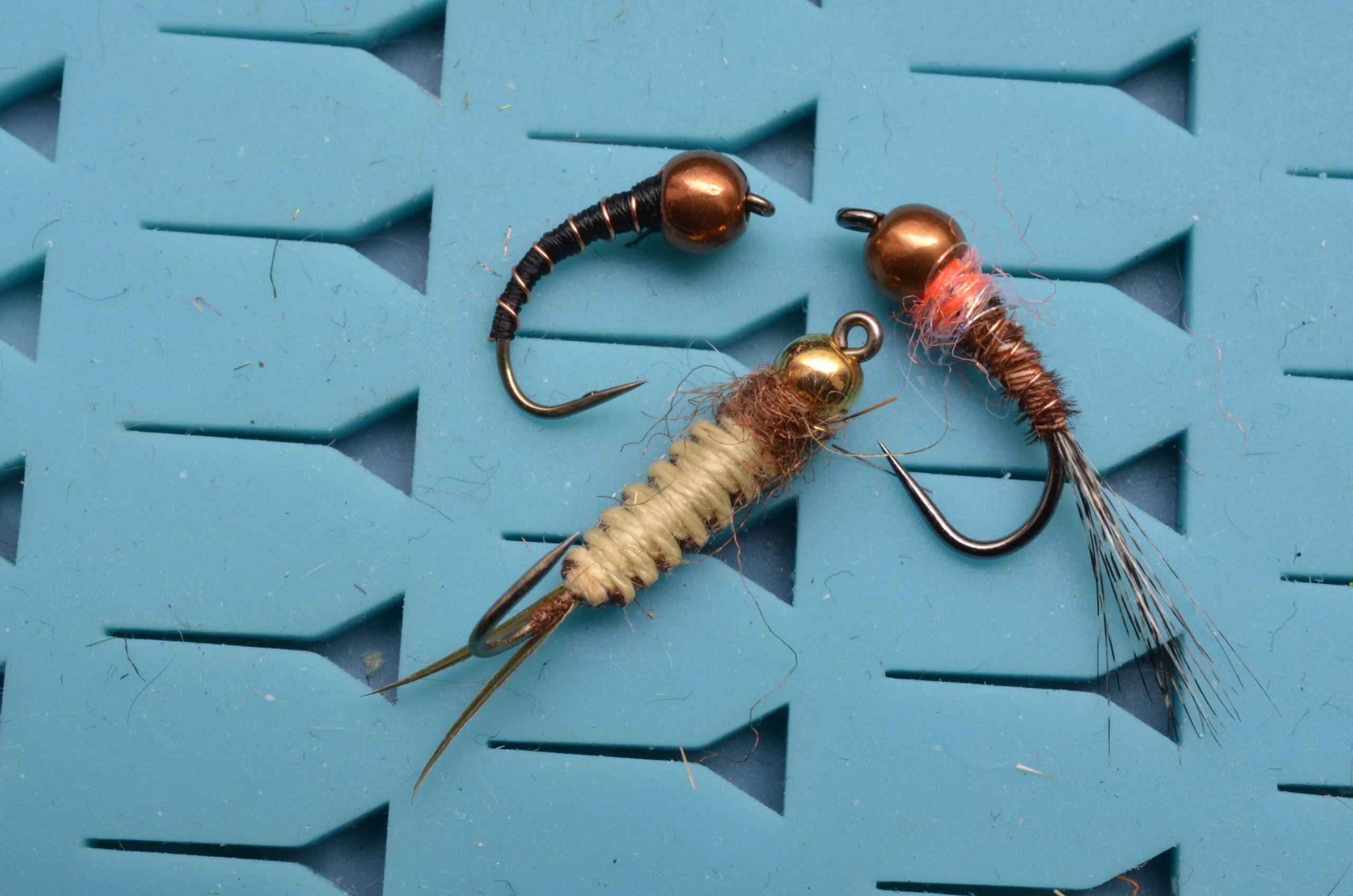
Three classic Euro nymphs. From left: Bead-Head Zebra Midge; Vladi’s Woven Nymph; and the Frenchie. (Photo/Morgan Lyle)
5 of the Best Euro Nymphs for Beginners
Euro nymphing is more about technique than specific flies. It will work with any nymph, provided the nymph has sufficient weight—usually from a tungsten bead—and a slim, dense body so it will sink quickly. Shaggy patterns with lots of lots of hackle, wings, tails, etc. aren’t great candidates, because the appendages interfere with their sink rate. A Prince Nymph, a Pheasant Tail, even a (reasonably neat) Hare’s Ear can work if they’re made with beads or lead underbodies. You can even get an unweighted nymph to sink quickly with a split shot a few inches up the leader (as long as you’re not fishing in a tournament governed by Fédération Internationale de Peche Sportive Mouche rules).
That said, there are patterns that have come to be associated with Euro nymphing, such as:
The Frenchie: Introduced to American anglers by competition angler Lance Egan, this fly features pheasant-tail body and a fish-eye-catching hot spot.
The Woven Nymph: This pattern was popularized by the great Polish angler Vladi Trzebunia. The clever construction of this style yields a segmented two-tone body, so you can give your fly the pale-belly, dark-back color scheme common to fish and aquatic insects.
The Bead-Head Zebra Midge: This Euro nymph is a well-established pattern of English descent that sinks fast and triggers trout with its simple, ribbed body.
The Perdigon: This is a smooth-bodied fly of Spanish ancestry, finished off with a coat of epoxy. It’s a remarkable fish-catcher, despite not looking very much like any real insect.
The Sexy Walt’s: A variation of the humble Walt’s Worm, the Sexy Walt’s was developed by Pennsylvania’s Walter Young, been dolled up with a shiny rib.

The slim Perdigon and a chunky caddis pupa pattern are both effective flies for Euro nymphing. (Photo: Morgan Lyle)
How to Set Up a Fly Rod for Euro Nymphing
Tight-line nymphing has been around for ages, but it became a full-blown category of fly-fishing when European tournament anglers developed workarounds for their contest rules. For example, no split shot or other weight is allowed on the line, so any fly meant to be fished more than a few inches deep was built with a metal bead to help it sink. Strike detectors were also prohibited, so the Euro anglers added brightly colored sections of monofilament to their leaders as sighters.
Long, light rods, typically 3- or 4-weights up to 11 feet, are helpful in this game. But the most pronounced feature of Euro nymphing gear is long leaders—20 feet or more, so long the actual fly line is seldom used at all. You cast the leader, not the line, which is a big departure from the classic fly cast, where a weight-forward fly line is used to pull the leader, the tippet, and the fly to the target water.
The Euro setup lets you fish 15 or 20 feet away with a direct connection from your rod tip to your fly—no line lying on the water, where currents can pull your fly off course, and no slack to spoil your hook-sets. You can drift a nymph through every pocket and seam, easily controlling its depth by the angle of your rod.
It’s remarkably effective, which you might expect of a technique widely used in world championship tournaments.
How to Make Your Own Euro-Nymphing Leader
Many companies now sell fly lines that are almost as thin as butt sections of leaders, because some competition rules or state fishing regs limit how long a leader can be. But it’s also easy to make your own long leader and attach it to whatever kind of fly line is on your reel.
Most leaders for Euro nymphing start with a long butt section, with 20-pound Maxima Chameleon being the most popular choice. The leader may include shorter sections of lighter pound-test material to create a taper. There’s often a segment of sighter material, either purpose-built or just some hi-viz spinning line, with a tippet ring at the end. From there you add your tippet, in the thickness and length you need for your fishing.
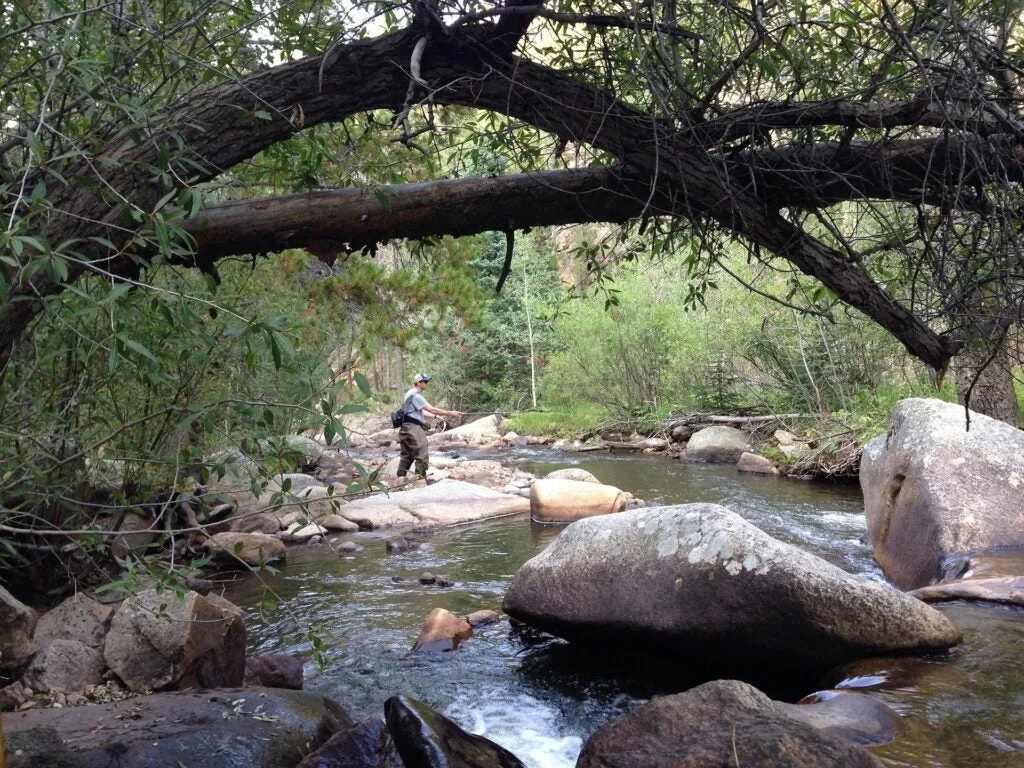
Tight-line nymphing is precise. It allows you to present wet flies in all kinds of fishing situations. (Photo: plantsandanimals1 via Pixabay.com)
5 Fishing Tips for European Nymphing
Casting a leader instead of a fly line takes some getting used to. A soft-action rod can help, but most trout rods are up to the task, once you dial in the necessary force and the timing. A single false cast is often enough to get the fly where it needs to go, especially since it usually isn’t going very far.
Fishing your Euro rig is straightforward: Drop your nymph upstream of every place that might hold a trout and drift it through. Most drifts will only take a few seconds. You’ll lift the nymph at the end of the drift and snap it into place for the next one quietly and efficiently. If there’s a trout nearby that’s at all inclined to eat, your rod will bend.
Here are a few tips to keep in mind if you give Euro nymphing a try:
1. Learn When to Set the Hook
You’ll feel plenty of takes on your tight Euro leader, but by no means all of them. Trout can take a nymph and then spit it back out so delicately that you never know it happened. Watch your sighter like a hawk, and set the hook at the slightest indication of an interruption in the drift.
2. Remember the Tuck Cast
Euro-nymphers love the tuck cast, for the way it punches their nymphs through the surface. It’s a simple trick to learn. Basically, just push a little too hard at the end of your forward cast. The result is nymphs that reach the desired depth more quickly.
3. Get Close to Trout, but Be Sneaky
Stealth is of utmost importance in close-range fishing. Avoid bright clothes, stay downstream of fish or spots where they’re likely to be, keep your shadow off the water, and don’t stumble around when you wade.
4. Run Two Heavy Nymphs on Your Line at Once
Two nymphs can be better than one. It’s a way to give the fish a choice between small and large, dark and light, slim and shaggy. Adding a heavy nymph can help a light one sink, and may pull strikes in its own right. The easiest way to add a dropper is to add another section to your tippet with a triple surgeon’s knot, leaving a tag of 8 inches or so where you can tie on the second fly.
5. Fish Every Inch of the Stream
Be thorough. Competition anglers spend three hours fishing beats as short as 100 yards, and they search every inch for trout. Certainly, fish the 4-foot-deep run and the pocket behind the boulder—but sneak up on the shallow flat and fish that, too. You might be surprised to make a good catch there, although the Euro guys aren’t surprised at all.
Know When and When Not to Try Euro Nymphing
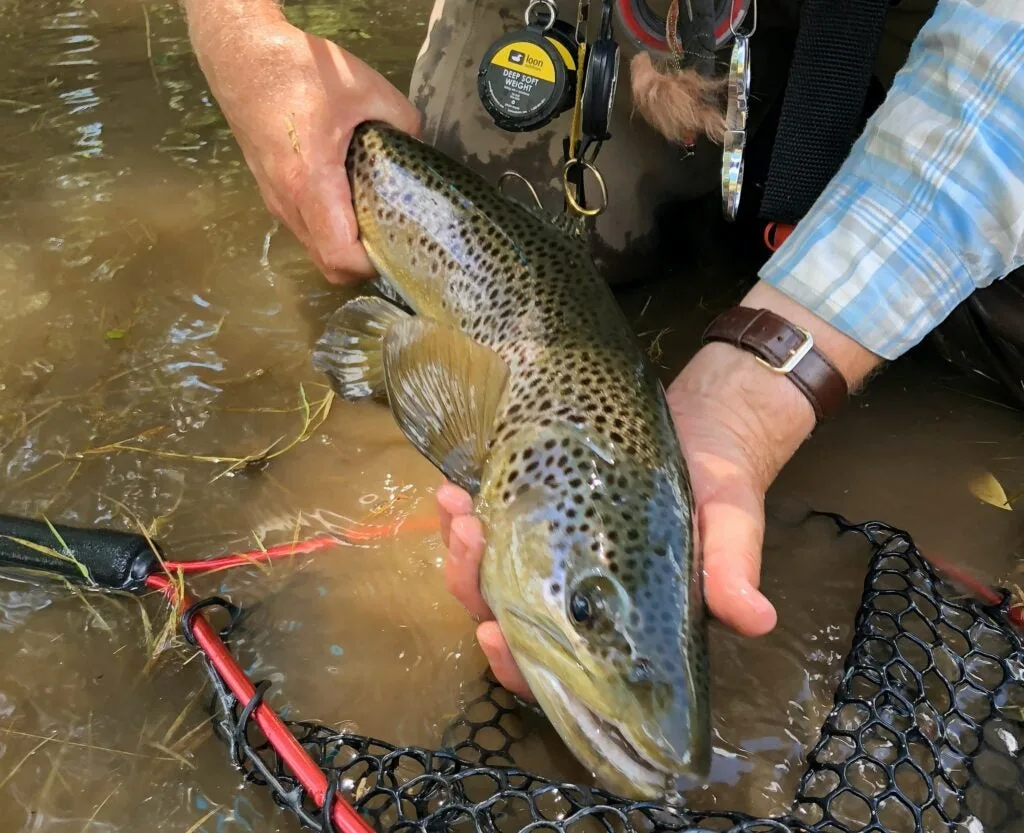
Euro-nymphing can help you catch trout in water with low visibility. (Photo: Rick Wallace via Unsplash.com)
Tight-line nymphing isn’t the best choice for all situations. You’re better off suspending your nymph under a strike indicator (or a buoyant dry fly) on slow-moving pools, when you need to fish at distance, or when the wind plays havoc with your Euro leader.
But when searching the pockets for trout, Euro nymphing is a very useful technique. Yes, your $80 fly line is reduced to the role of backing, but you can swap in a standard leader and cast in the classic way if the trout start rising to a hatch. In the meantime, you may see a welcome increase in your catch rate, even if you’re only competing with yourself.
The European Approach to Nymphing
Czech vs. Polish vs. French vs. Spanish Nymphing
Anglers in the countries where this kind of trout fishing developed have somewhat different ways of accomplishing that goal. Czech and Polish trout fishers developed the kind of fishing most often identified as Euro nymphing: drifting a pair of weighted nymphs through the deep runs, plunge pools, and miniature eddies of swift, rocky streams. It’s easy to sneak up on trout in noisy, broken water, and the fishing is close-quarters—sometimes directly below your rod tip. French and Spanish anglers, on the other hand, are known for lighter flies and very long leaders, which are much better suited to shallow riffles or pools and spooky fish.
Both approaches are based on the same principle: cast upstream, so the fly floats down to the trout. These fish were built to feed on what the current brings to them. But flies that drift and bounce along the bottom tend to get snagged on rocks, aquatic weeds, or woody debris. Euro anglers invented the concept of “leading” their flies, pulling them downstream just a little faster than the current—not so much that the fly appears to be racing, but enough to keep it from dropping into the snags.

